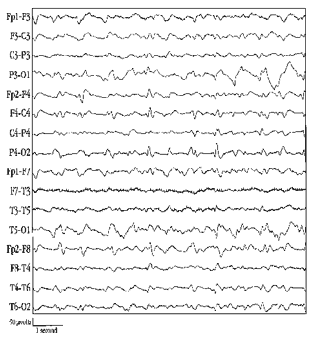How to Read an EEG
This section gives a brief introduction to how EEG electrodes are set up, what they mean and what the doctors can learn from reading an EEG.
Learn More:
Find Your Local Epilepsy FoundationHow Are The Electrodes Arranged?
An EEG technicial places the electrodes in specific areas, according to internationally agreed-upon criteria.
- To find where to put the electrodes, first the technician marks four points on your head - the nasion (indentation between the forehead and the nose), the inion (ridge that can be felt in the middle of the back of the skull, over the occipital area), and the preauricular points on both sides of the head (indentations above the outer part of the ear openings).
- The electrode are then placed in many areas on the head, at specific locations and distances from these landmarks or points listed above.
- Sometimes other electrodes (sphenoidal and suboccipital, for instance) are placed to increase the chance of recording EEG waves from areas that may be too small or too deep to be recorded by the usual electrodes.
- Often an electrode is placed on the chest to record the EKG (electrocardiogram) which is a a record of the heartbeat.
What Do The Letters And Numbers Mean?

Image: EEG of a generalized seizure
The names of the electrode sites use alphabetical abbreviations that identify the lobe or area of the brain which each electrode records from:
- F = frontal
- Fp = frontopolar
- T = temporal
- C = central
- P = parietal
- O = occipital
- A = auricular (ear electrode)
The localization of the brain waves within the brain regions or lobes is further narrowed by adding electrodes, which are given numbers such as T3, T4, P3, P4. Even numbers identify electrode positions on the right side of the head, and odd numbers refer to the left side. The label "z" points to electrode sites in the midline of the head. For example, Cz refers to the midline central region of the head.
How Are The Electrodes Related To Each Other?
The EEG records brain waves using equipment called amplifiers and by looking at the information from the electrodes in different combinations. These combinations of electrodes are called 'montages'.
- In bipolar montages, consecutive pairs of electrodes are linked by connecting the electrode input 2 of one channel to input 1 of the subsequent channel, so that adjacent channels have one electrode in common. The bipolar chains of electrodes may be connected going from front to back (longitudinal) or from left to right (transverse).
- Another type of montage is the referential montage. In this type, various electrodes are connected to input 1 of each amplifier and a reference electrode is connected to input 2 of each amplifier. Ideally, inactive electrodes (ones that are uninvolved in the electrical field being studied) are chosen as references.
What Does The Doctor Learn From Looking At The EEG?
Being able to locate the origin of electrical activity ("localization") is critical to being able to interpret the EEG tracings meaningfully.
- Localizing normal or abnormal brain waves in bipolar montages is usually accomplished by identifying "phase reversal," a deflection of the two channels within a chain pointing to opposite directions.
- In a referential montage, all channels may show deflections or movements in the same direction. If the electrical activity at the active electrodes is positive when compared to the activity at the reference electrode, the deflection will be downward. Electrodes where the electrical activity is the same as at the reference electrode will not show any deflection. In general, the electrode with the largest upward deflection represents the maximum negative activity in a referential montage.
Learn More:
Donate to Support Our MissionResources
Epilepsy Centers
Epilepsy centers provide you with a team of specialists to help you diagnose your epilepsy and explore treatment options.
Epilepsy Medication
Find in-depth information on anti-seizure medications so you know what to ask your doctor.
Epilepsy and Seizures 24/7 Helpline
Call our Epilepsy and Seizures 24/7 Helpline and talk with an epilepsy information specialist or submit a question online.
Tools & Resources
Get information, tips, and more to help you manage your epilepsy.



